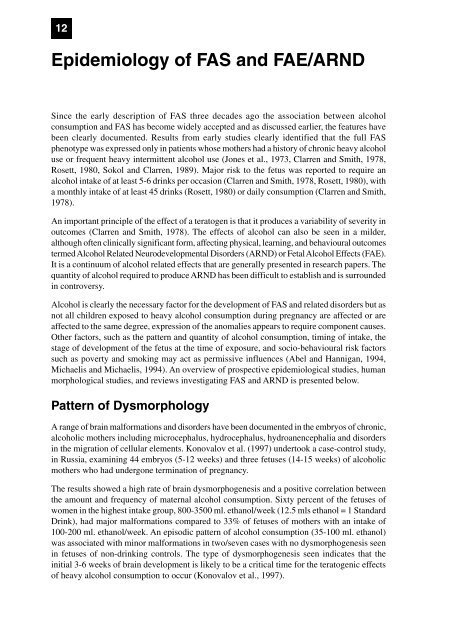Fetal Alcohol Syndrome A literature review - Department of Health ...
Fetal Alcohol Syndrome A literature review - Department of Health ...
Fetal Alcohol Syndrome A literature review - Department of Health ...
You also want an ePaper? Increase the reach of your titles
YUMPU automatically turns print PDFs into web optimized ePapers that Google loves.
12<br />
Epidemiology <strong>of</strong> FAS and FAE/ARND<br />
Since the early description <strong>of</strong> FAS three decades ago the association between alcohol<br />
consumption and FAS has become widely accepted and as discussed earlier, the features have<br />
been clearly documented. Results from early studies clearly identified that the full FAS<br />
phenotype was expressed only in patients whose mothers had a history <strong>of</strong> chronic heavy alcohol<br />
use or frequent heavy intermittent alcohol use (Jones et al., 1973, Clarren and Smith, 1978,<br />
Rosett, 1980, Sokol and Clarren, 1989). Major risk to the fetus was reported to require an<br />
alcohol intake <strong>of</strong> at least 5-6 drinks per occasion (Clarren and Smith, 1978, Rosett, 1980), with<br />
a monthly intake <strong>of</strong> at least 45 drinks (Rosett, 1980) or daily consumption (Clarren and Smith,<br />
1978).<br />
An important principle <strong>of</strong> the effect <strong>of</strong> a teratogen is that it produces a variability <strong>of</strong> severity in<br />
outcomes (Clarren and Smith, 1978). The effects <strong>of</strong> alcohol can also be seen in a milder,<br />
although <strong>of</strong>ten clinically significant form, affecting physical, learning, and behavioural outcomes<br />
termed <strong>Alcohol</strong> Related Neurodevelopmental Disorders (ARND) or <strong>Fetal</strong> <strong>Alcohol</strong> Effects (FAE).<br />
It is a continuum <strong>of</strong> alcohol related effects that are generally presented in research papers. The<br />
quantity <strong>of</strong> alcohol required to produce ARND has been difficult to establish and is surrounded<br />
in controversy.<br />
<strong>Alcohol</strong> is clearly the necessary factor for the development <strong>of</strong> FAS and related disorders but as<br />
not all children exposed to heavy alcohol consumption during pregnancy are affected or are<br />
affected to the same degree, expression <strong>of</strong> the anomalies appears to require component causes.<br />
Other factors, such as the pattern and quantity <strong>of</strong> alcohol consumption, timing <strong>of</strong> intake, the<br />
stage <strong>of</strong> development <strong>of</strong> the fetus at the time <strong>of</strong> exposure, and socio-behavioural risk factors<br />
such as poverty and smoking may act as permissive influences (Abel and Hannigan, 1994,<br />
Michaelis and Michaelis, 1994). An overview <strong>of</strong> prospective epidemiological studies, human<br />
morphological studies, and <strong>review</strong>s investigating FAS and ARND is presented below.<br />
Pattern <strong>of</strong> Dysmorphology<br />
A range <strong>of</strong> brain malformations and disorders have been documented in the embryos <strong>of</strong> chronic,<br />
alcoholic mothers including microcephalus, hydrocephalus, hydroanencephalia and disorders<br />
in the migration <strong>of</strong> cellular elements. Konovalov et al. (1997) undertook a case-control study,<br />
in Russia, examining 44 embryos (5-12 weeks) and three fetuses (14-15 weeks) <strong>of</strong> alcoholic<br />
mothers who had undergone termination <strong>of</strong> pregnancy.<br />
The results showed a high rate <strong>of</strong> brain dysmorphogenesis and a positive correlation between<br />
the amount and frequency <strong>of</strong> maternal alcohol consumption. Sixty percent <strong>of</strong> the fetuses <strong>of</strong><br />
women in the highest intake group, 800-3500 ml. ethanol/week (12.5 mls ethanol = 1 Standard<br />
Drink), had major malformations compared to 33% <strong>of</strong> fetuses <strong>of</strong> mothers with an intake <strong>of</strong><br />
100-200 ml. ethanol/week. An episodic pattern <strong>of</strong> alcohol consumption (35-100 ml. ethanol)<br />
was associated with minor malformations in two/seven cases with no dysmorphogenesis seen<br />
in fetuses <strong>of</strong> non-drinking controls. The type <strong>of</strong> dysmorphogenesis seen indicates that the<br />
initial 3-6 weeks <strong>of</strong> brain development is likely to be a critical time for the teratogenic effects<br />
<strong>of</strong> heavy alcohol consumption to occur (Konovalov et al., 1997).

















